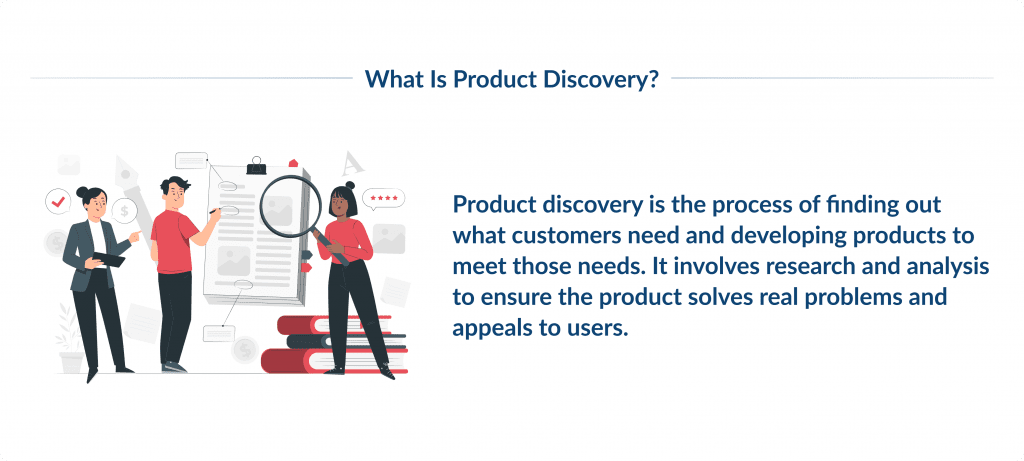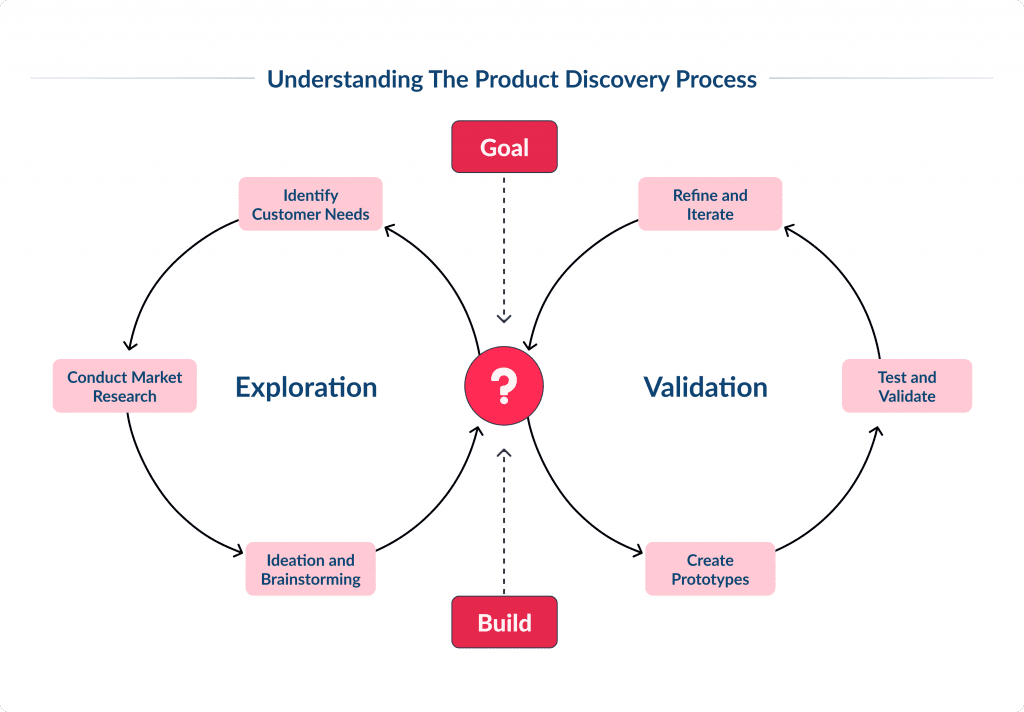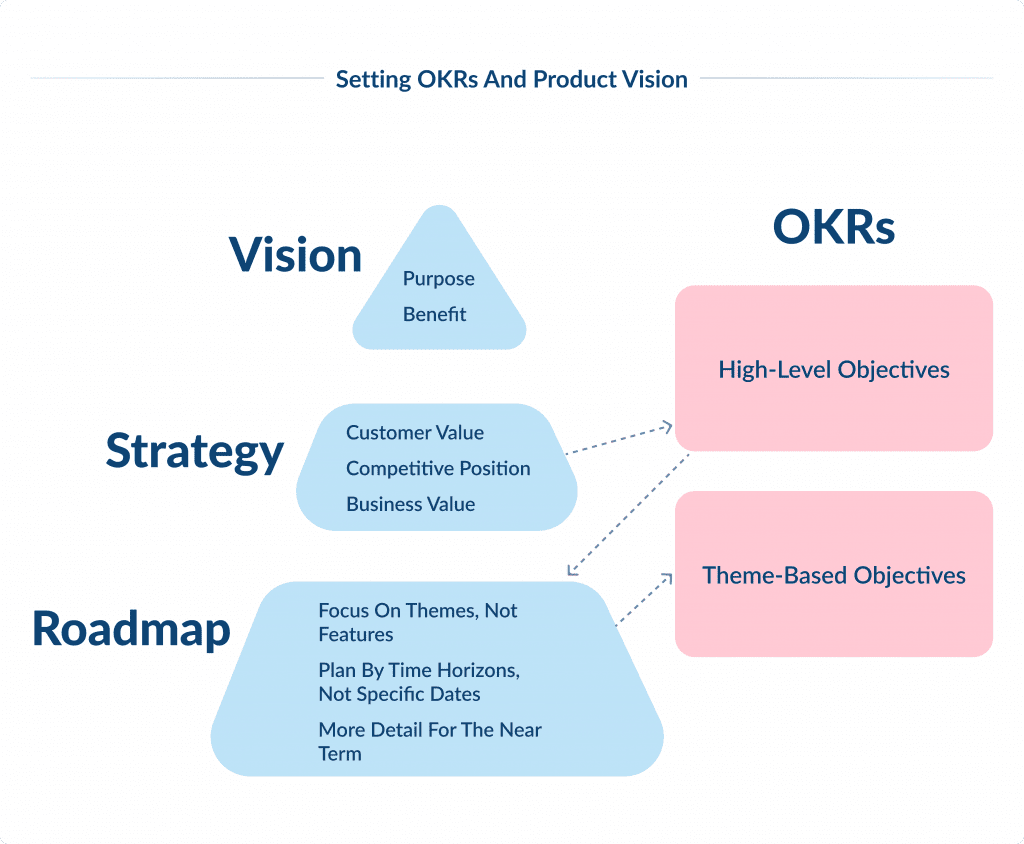Product Discovery Phase: It’s Role in Software Development
- Updated: Nov 07, 2024
- 15 min
Imagine investing months of effort and thousands of dollars into developing a SaaS product, only to find out that nobody wants it.
This scenario is more common than you’d think.
According to CB Insights, 42% of startups fail because there’s no market need for their product.
So, how do you discover your product is actually useful?
Enter the product discovery services.
The product discovery process is a crucial step in software development that can make or break your project.
In fact, many top companies out there started off focusing on understanding user needs and market demands.
Slack and Dropbox, for example, both have turned initial insights into billion-dollar businesses.
In this article, we uncover why it is important to master the product discovery process and how it can save you from costly missteps.
Not sure which software model is right for you? Explore the ASP model vs SaaS model breakdown.
Let's shape your startup's product vision together!
Product Discovery Process Overview
Slack is a great example of product discovery.
Slack, a messaging app for teams, launched in August 2013.
Email, Skype and HipChat own the communication space, but Slack differentiates itself by being deeply integrated with all the tools teams already use.
Slack’s history goes back to a gaming company called Tiny Speck, founded by Stewart Butterfield.
During the development of their game Glitch, the development team needed a better way to communicate and collaborate.
The existing tools were not working, so they built their own internal messaging system.
When Glitch failed, Butterfield realized the messaging tool they had built was super effective and could be a standalone product.
This was the idea of Slack.
Before they launched their product, the Slack team did a ton of user research and tested with various companies.
They gathered feedback to see how people used communication tools and what features were most important.
This understanding of user stories, needs and behavior was key.
As part of their product discovery Slack identified the pain points of existing tools: poor integration, clunky interfaces and fragmented communication.
With a deep understanding of these problems they built a solution that wasn’t just another messaging app but a tool that simplified communication and increased productivity.
If you want to create an app with seamless chats to satisfy your users — check out how to create a messaging app step by step.
The product discovery phase helped Slack get it right from day one.
They knew what people wanted and how they used communication tools so Slack met those needs.
So Slack took off.
It’s a go to tool for team communication and collaboration in many companies.
So what is product discovery and how do you do it?
Let’s get into it.
What is Product Discovery?
Product discovery means finding out what customers need and developing products that satisfy those needs.
At this stage, product development teams discover problems that potential customers are willing to pay for but aren’t solved by other products on the market. 
The Importance of Product Discovery for Product Teams
A product management process is incomplete without product discovery.
This stage helps mitigate the risk connected to product development.
Furthermore, the product discovery process eliminates the chances of developing something that customers simply do not need. This risk is also known as value risk.
On top of that, during product discovery, teams address usability risks and check if the product is easy to use.
Additionally, the product discovery process is aimed at discovering if the solution you are building is actually aligned with your business goals.
Finally, this stage is needed to make sure you indeed have the resources to build the product. This reduces feasibility risk.
Product Discovery Process Benefits
Launching a product that does more than meet customer expectations and solves real problems.
This is what product discovery is.
Your product team spends time and effort upfront, understanding your market, and validating ideas to ensure a successful launch and growth.
Here’s how product discovery can change your development process:
Customer Needs
The product discovery process helps teams understand what customers want.
When your product team talks to users through interviews, focus groups, surveys and observations, they can find real pain points and design products to solve those problems.
Also, using a CLTV calculator is a smart move for any business looking to get the most profit from each customer relationship.
Minimizing Risk
Spending time on product discovery minimizes the risk of building something that doesn’t meet market demand.
Minimum viable product development, prototyping and testing early in the development process can help product teams avoid costly mistakes and ensure their efforts meet user and market needs.
If you are looking for tips on how to ensure your product is easy to use, check out these five usability testing ways that will help elevate your startup’s performance.
Team and Stakeholder Alignment
Product discovery aligns team and stakeholders.
Clear communication and a shared understanding of the product vision and goals means everyone is on the same page.
This is key to successful product development.
Resource Optimization
Product discovery helps allocate resources efficiently as it’s focused on validated ideas.
Product teams can prioritize features and development that will have the biggest impact, so time, money, and effort are spent on the most promising parts of the product.
Innovation
Product discovery encourages thinking outside the box.
Prototyping can help teams come up with new ways and breakthroughs that make their product unique.
Better Products
Ultimately product discovery means products that meet customer needs and expectations.
This process means the final product is user centric, solves real problems and delivers real value to the user.
Market Success
A good product discovery phase means market success.
Products built from research and validated ideas will resonate more with users, and have higher adoption rates and better business outcomes.
Let’s see what this process involves. 
Understanding The Product Discovery Process
The product discovery phase involves research, ideation, and validation to ensure that the product concept is viable and valuable.
Here’s our own step-by-step product discovery process.
Step 1: Understanding the Problem
Product development process starts with client interview.
At this point, we discover their business idea, why they think it is important, what features they want to implement, etc.
We also ask about the audience they want to target, the monetization model, and the desired outcome.
Step 2: Market Research
Next, we conduct market research to uncover the problem your product will solve.
Using Lean Startup and Design Thinking, we first analyze current solutions.
Then, we research users and competitors to shape the product’s features.
We use customer feedback surveys, interviews, and product usage analysis techniques.
Custoner feedback helps us improve our products and provide a better user experience.
Step 3: Ideation and Prototyping
In this phase, as a part of our digital design services, we create prototypes and wireframes to build the user experience.
This process helps us craft a concept that users will love and clearly demonstrates the product’s value.
The client’s feedback is crucial in this stage, so we iterate on these designs and incorporate feedback.
Then, we create a clickable prototype that is ready for testing.
This prototype allows us to visualize the product’s function and gather initial user reactions.
Step 4: Validation and Refinement Based on Customer Feedback
We then move to testing our business hypotheses, ensuring that the product aligns with user needs and market demands.
We gather customer feedback and conduct rigorous testing to refine and enhance the product.
This process helps us shape solid requirements based on your product’s core values.
The technical specifications will define roles, use cases, and system requirements, establishing the necessary scope of work for development.
This step ensures that the final product is well-defined and ready for successful implementation.
When the client approves the idea, we move on to product roadmap creation.
After that, we can start MVP development.
The Product Discovery Process: Initial vs. Continuous Discovery
Product discovery can be divided into two main phases: initial discovery and continuous discovery.
Here’s what these phases mean.
Initial Product Discovery is where the product development starts.
Here, we identify potential ideas for new products or significant enhancements to existing ones.
This involves a deep dive into market needs, user pain points, and opportunities that the product can address.
Continuous Product Discovery is an ongoing process that takes place throughout the product’s lifecycle.
A continuous discovery process means that we are constantly gathering customer feedback, insights, and data to continually improve and innovate the product.
The initial discovery, on the other hand, mainly focuses on ideation and concept validation.
Key Differences
- Focus: initial discovery is about finding the right product idea. Continuous discovery is about refining and evolving the product based on ongoing user feedback.
- Methods: Initial discovery involves broader research methods like market analysis and user personas. Continuous discovery utilizes ongoing methods such as user feedback surveys, A/B testing, and usage analytics.
- Outcome: The initial discovery aims to create a validated product concept. Continuous discovery aims to keep the product relevant, user-friendly, and competitive over time.
Both phases are crucial for long-term success.
Initial discovery helps you start with a solid foundation and address a real market need.
Continuous discovery ensures the product remains valuable and up-to-date as you adapt to changing user requirements and market conditions.
Defining Direction and Priorities: Setting OKRs and Product Vision
As a product manager, it’s crucial to recognize that not all user problems can or should be solved.
Some issues may fall outside the scope of your product vision or strategic goals.
Tools like OKRs (Objectives and Key Results) and the Opportunity Solution Tree (OST) are invaluable for effectively prioritizing and aligning efforts during product discovery.
Let’s explore them all.
How to Set OKRs for Product Discovery
OKRs are a framework used to define and track objectives and their outcomes.
They help set clear, measurable goals aligning with the overall product vision and business strategy.
For example, a Spotify product manager might set an OKR to improve user engagement by 20% in the next quarter.
The key results to achieve this objective could include increasing daily active users, enhancing playlist personalization, and reducing app load time.
If there’s a specific decision that the research will enable, commit to making that decision.
It is important to note that OKRs are not meant to be a list of tasks, so you don’t need to outline each step of your discovery research.
If you think you can build a prototype and launch it to a test audience before the end of the quarter, commit to the launch of the test.
This is what you can do: you can have a KR to launch a new service to a small percentage of your users.
Selecting the tech for that service can take you approximately 2 months of discovery research, but the outcome you committed to in your OKR will be just the actual test launch. 
Defining Product Vision
In essence, the product vision explains what the product aims to accomplish over the long run.
It guides all product development activities, ensuring that the team stays focused on the important things.
A well-defined product vision helps make strategic decisions and prioritize tasks that align with the ultimate goal.
For example, a Tesla product vision to accelerate the world’s transition to sustainable energy is the driving force behind its innovations in electric vehicles and renewable energy.
Using the Opportunity Solution Tree (OST)
An OST is a strategic tool used for mapping user pain points and opportunities to align them with business objectives.
The process starts with identifying user problems and then exploring various solutions to address them.
The tree visually breaks down the opportunities into smaller, actionable steps to show each aligns with broader business goals.
For example, if a product manager at a fitness app development company finds that users struggle with motivation, the OST might outline opportunities like to introduce gamification features, offer personalized workout plans, and create a community forum.
Why are these tools efficient in the product discovery solution space?
When setting OKRs and using tools like the OST, product teams can focus on solving the most impactful problems in line with the product vision.
This approach helps maintain strategic alignment and effectively use available resources to deliver maximum value to users.
Disocver all you need to know about market research methods, types & examples
Effective Collaboration with a Product Team During the Discovery Phase
After 10+ years of product development, we have refined our product discovery process and our communication approach to get the best results for our clients.
Here’s how we do actual team work through collaboration.
First is communication.
We believe communication is key during product discovery.
It helps to build relationships with customers and business stakeholders.
We have regular updates and feedback sessions to keep everyone informed and involved.
This way we can catch issues early and make adjustments.
Transparency in decision making is key.
From our side we always explain the reasoning behind our decisions, build trust and make sure everyone knows where the project is heading.
We use collaborative tools like Slack and Jira to facilitate communication and documentation.
These tools help us to stay connected, share updates and track progress in real time.
This is especially useful when working across multiple time zones.
Customer interviews, surveys and workshops give us valuable insights into customers and stakeholders.
This resulted in features based on real user feedback and higher user satisfaction.
In short, our product discovery approach is communication and collaboration.
So, what can you expect as deliverables from our product discovery efforts?
Product Discovery Phase Deliverables
Here’s what our clients receive after we conduct user research, propose solutions, and analyze the product.
UX Design
Our team develops a high-quality and functional prototype to demonstrate how the app will work.
We also provide a detailed project vision that outlines the main objectives and the proposed solution.
This helps you clearly understand the product’s potential and future prospects so that we always know what to expect.
For example, if we design a new e-commerce platform, you’ll see interactive mockups showing user navigation, product pages, and checkout processes.
Want to join the booming eCommerce market? Learn how to develop an eCommerce app that meets customer needs.
Project Documentation
You will receive comprehensive project documentation and spreadsheets.
This includes a conceptual description of the future MVP in business model and a detailed description of all product-related business processes.
This documentation covers requirements, functionality, team structure, marketing strategy for a new product, and financial aspects.
Solution Definition
You will be able to understand the entire mobile app development process from start to finish.
This includes detailed information on the technology stack, wireframes, architecture, databases, and programming languages that will be used.
For instance, you’ll know whether we’re using React for the front end and Node.js for the back end, as well as how data will be stored and managed.
Get the details on the cost to hire a React.js developer and what factors can influence rates.
This clarity ensures you’re fully informed about the technical aspects of the development journey.
With these deliverables, you’ll have a clear and actionable blueprint for your product’s success.
Learn about the key factors that influence app development costs and how to budget effectively for your project.
Common Pitfalls in Product Discovery and How to Overcome Them
Now we’ve covered the deliverables, let’s dive into the pitfalls we might face during product discovery and how we can navigate them.
Knowing how to get around these will mean successful product delivery.
One big product discovery pitfall is not understanding customer needs
Many teams start with assumptions, not facts, and end up with a product that doesn’t solve real problems.
Imagine a team decides to build a fitness app. They assume users want:
- Predefined workout plans.
- A feature to track calories burned.
They build the app based on these assumptions without speaking to potential users.
When the app launches, it turns out most users wanted:
- Personalized workout suggestions based on their fitness levels.
- A habit tracker for consistency.
The app flops because it doesn’t meet users’ actual needs.
Instead of relying on assumptions, the team could do user research first:
- Talk to 10-15 people who regularly use fitness apps. Ask them questions like:
- “What challenges do you face in staying consistent with workouts?”
- “What do you love or hate about the fitness apps you use now?”
- Send out a short questionnaire to a broader audience asking:
- “What’s the most important feature in a fitness app for you?”
- “What would make you stop using a fitness app?”
Interviews and surveys will help your product team avoid the guesswork and create a product development plan that will cover features people will really need and enjoy using.
Another product discovery pitfall is not doing thorough market research.
Without proper market research, product teams will enter a crowded market or miss out on competitive and valuable insights.
Market analysis can reveal gaps and opportunities, as Dropbox did when it saw the need for simple, reliable cloud storage among more complex competitors.
Ignoring user feedback is another product discovery mistake.
Products will miss the mark if product teams don’t include user input.
Here is how that can happen:
A team creates a messaging app with features they believe are innovative, such as:
- A “message bomb” feature that deletes texts after 10 seconds.
- A colorful, highly animated interface.
During early testing, users complain that:
- The “message bomb” feature is stressful because messages disappear too quickly.
- The animated interface makes it hard to focus on conversations.
The product team dismisses this feedback as they think users will get used to this uniqueness.
However, it didn’t happen as expected and when the app launches, most people don’t like it.
They find the disappearing messages impractical and the animations feel distracting.
That is why users abandon the app, and the product fails.
How the team can fix it?
By listening to the users and taking actions.
Before fully launching the app, the team releases a beta version to a small group of users and collects feedback.
After getting feedback, they:
- Adjust the “message bomb” to let users set custom time limits.
- Simplify the interface for a cleaner, less distracting design.
They make small updates and test again with the same or new users. This process repeats until users are happy.
Iterative testing and feedback loops are key.
Too much focus on features is another product discovery issue.
Too much focus on adding features rather than solving core problems will result in a product that’s bloated.
Let’s imagine a team decides to create a meal planning app. They include every feature they can think of:
- A barcode scanner for groceries.
- A calorie tracker.
- A recipe recommendation engine.
- A social feed to share meals.
- An AI chatbot for dietary advice.
While these features seem exciting, they forget to focus on the core problem users want solved: quick and easy meal planning.
So, when users try the app, they’re overwhelmed:
- The interface is cluttered because of all the features.
- Simple tasks like creating a weekly meal plan take too long.
As a result, users abandon the app for simpler alternatives.
How can a team fix it?
First, they should conduct surveys and interviews to find out what users really want.
For example, users might say, “I want a tool to plan meals for the week in 5 minutes.”
Based on the data from their potential users, the team prioritizes features that directly solve the core problem, such as:
- A quick meal planning tool.
- A grocery list generator based on the plan.
Then, the development team can start building the core features to release the app and collect user feedback.
And only add new features if the target audience requests them and they align with the core purpose of the product.
Poor problem definition is another common product discovery problem.
Without a clear problem definition product teams will get lost.
Define the problem statement clearly and make sure it aligns with user needs.
Sebastien Phlix, Product Manager at N26, suggests using five key filters to determine which ideas are worth pursuing:
- Does it align with business goals? If an idea doesn’t support the metrics or company goals your team is working on, put it on the backburner for now.
- Is it relevant to your target audience? Use the research you did earlier to see if the idea meets the needs of your users.
- Do the numbers add up? Quickly calculate which metric the idea will impact and by how much. This helps you compare different solutions to a problem.
- Are people asking for it? Consider feedback from customers or stakeholders who have asked for similar ideas.
- Would it be a mistake not to pursue it? Ask your team this and you’ll surface interesting insights and good ideas that would otherwise be ignored.

Once you have your ideas, use a prioritization framework to score them on value and feasibility, and evaluate each idea.
Poor prototyping will cost you later.
Investing time in prototyping early will save you resources.
And misalignment with business goals will waste resources.
Make sure the product discovery is aligned with the company’s strategy.
Need a reliable development team? Here’s your step-by-step guide to hiring a dedicated team in Ukraine.
Wrapping Up: Why Is Product Discovery Important?
Product discovery is an essential stage of the development process.
With a deep understanding of customers, their needs, and pain points, product teams create products that people truly want and need.
This product discovery process moves teams beyond “nice to have” features to build solutions that solve real problems and become essential for customers.
Successful product discovery benefits the product team, the company, and the customers.
It ensures that resources aren’t wasted on developing unwanted products and instead focuses on delivering something customers may consider vital.
Are you ready to embark on a product discovery journey with us?
We utilize the best product discovery techniques to ensure the proposed solutions meet your needs and business objectives.
Tell us about what you want to build, and we will conduct in-depth market and customer research to validate your business idea.













